Financial Services Legislation & Compliance Assessment AAMC Training
VerifiedAdded on 2023/05/31
|18
|6437
|96
Homework Assignment
AI Summary
This assignment solution provides answers to questions related to financial services legislation and compliance. It covers the roles of ASIC and ASX as regulators, dispute resolution processes (IDR and EDR), information requirements for financial advisors, Australian Privacy Principles, skills needed to be a mortgage broker, and statutory records under the NCCP. The solution also includes research on financial service providers like National Australia Bank, Homeloans Limited, Peoples Choice Credit Union, and Pepper, along with case study questions addressing responsible lending obligations and related scenarios.
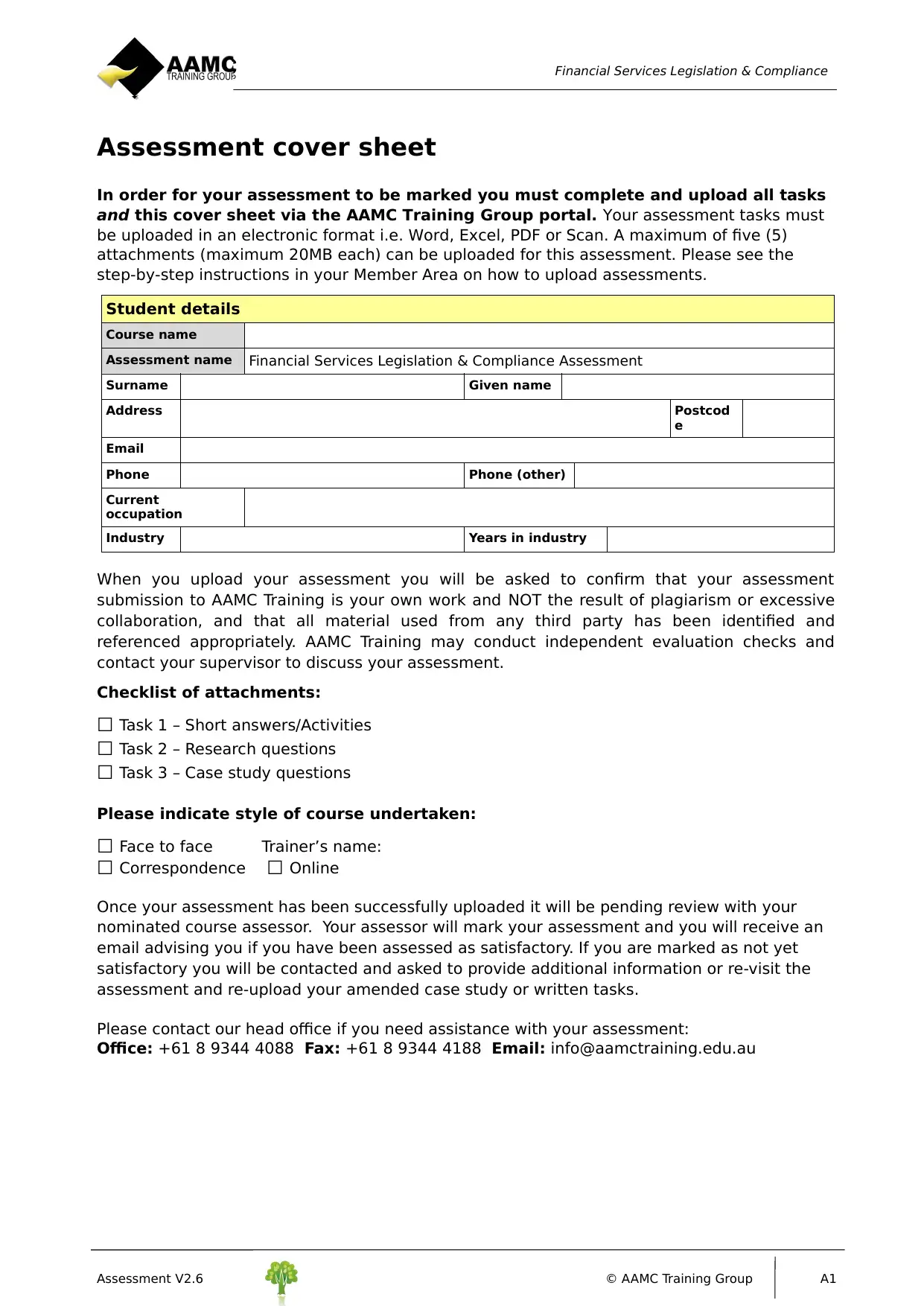
Financial Services Legislation & Compliance
Assessment cover sheet
In order for your assessment to be marked you must complete and upload all tasks
and this cover sheet via the AAMC Training Group portal. Your assessment tasks must
be uploaded in an electronic format i.e. Word, Excel, PDF or Scan. A maximum of five (5)
attachments (maximum 20MB each) can be uploaded for this assessment. Please see the
step-by-step instructions in your Member Area on how to upload assessments.
Student details
Course name
Assessment name Financial Services Legislation & Compliance Assessment
Surname Given name
Address Postcod
e
Email
Phone Phone (other)
Current
occupation
Industry Years in industry
When you upload your assessment you will be asked to confirm that your assessment
submission to AAMC Training is your own work and NOT the result of plagiarism or excessive
collaboration, and that all material used from any third party has been identified and
referenced appropriately. AAMC Training may conduct independent evaluation checks and
contact your supervisor to discuss your assessment.
Checklist of attachments:
☐ Task 1 – Short answers/Activities
☐ Task 2 – Research questions
☐ Task 3 – Case study questions
Please indicate style of course undertaken:
☐ Face to face Trainer’s name:
☐ Correspondence ☐ Online
Once your assessment has been successfully uploaded it will be pending review with your
nominated course assessor. Your assessor will mark your assessment and you will receive an
email advising you if you have been assessed as satisfactory. If you are marked as not yet
satisfactory you will be contacted and asked to provide additional information or re-visit the
assessment and re-upload your amended case study or written tasks.
Please contact our head office if you need assistance with your assessment:
Office: +61 8 9344 4088 Fax: +61 8 9344 4188 Email: info@aamctraining.edu.au
Assessment V2.6 © AAMC Training Group A1
Assessment cover sheet
In order for your assessment to be marked you must complete and upload all tasks
and this cover sheet via the AAMC Training Group portal. Your assessment tasks must
be uploaded in an electronic format i.e. Word, Excel, PDF or Scan. A maximum of five (5)
attachments (maximum 20MB each) can be uploaded for this assessment. Please see the
step-by-step instructions in your Member Area on how to upload assessments.
Student details
Course name
Assessment name Financial Services Legislation & Compliance Assessment
Surname Given name
Address Postcod
e
Phone Phone (other)
Current
occupation
Industry Years in industry
When you upload your assessment you will be asked to confirm that your assessment
submission to AAMC Training is your own work and NOT the result of plagiarism or excessive
collaboration, and that all material used from any third party has been identified and
referenced appropriately. AAMC Training may conduct independent evaluation checks and
contact your supervisor to discuss your assessment.
Checklist of attachments:
☐ Task 1 – Short answers/Activities
☐ Task 2 – Research questions
☐ Task 3 – Case study questions
Please indicate style of course undertaken:
☐ Face to face Trainer’s name:
☐ Correspondence ☐ Online
Once your assessment has been successfully uploaded it will be pending review with your
nominated course assessor. Your assessor will mark your assessment and you will receive an
email advising you if you have been assessed as satisfactory. If you are marked as not yet
satisfactory you will be contacted and asked to provide additional information or re-visit the
assessment and re-upload your amended case study or written tasks.
Please contact our head office if you need assistance with your assessment:
Office: +61 8 9344 4088 Fax: +61 8 9344 4188 Email: info@aamctraining.edu.au
Assessment V2.6 © AAMC Training Group A1
Paraphrase This Document
Need a fresh take? Get an instant paraphrase of this document with our AI Paraphraser
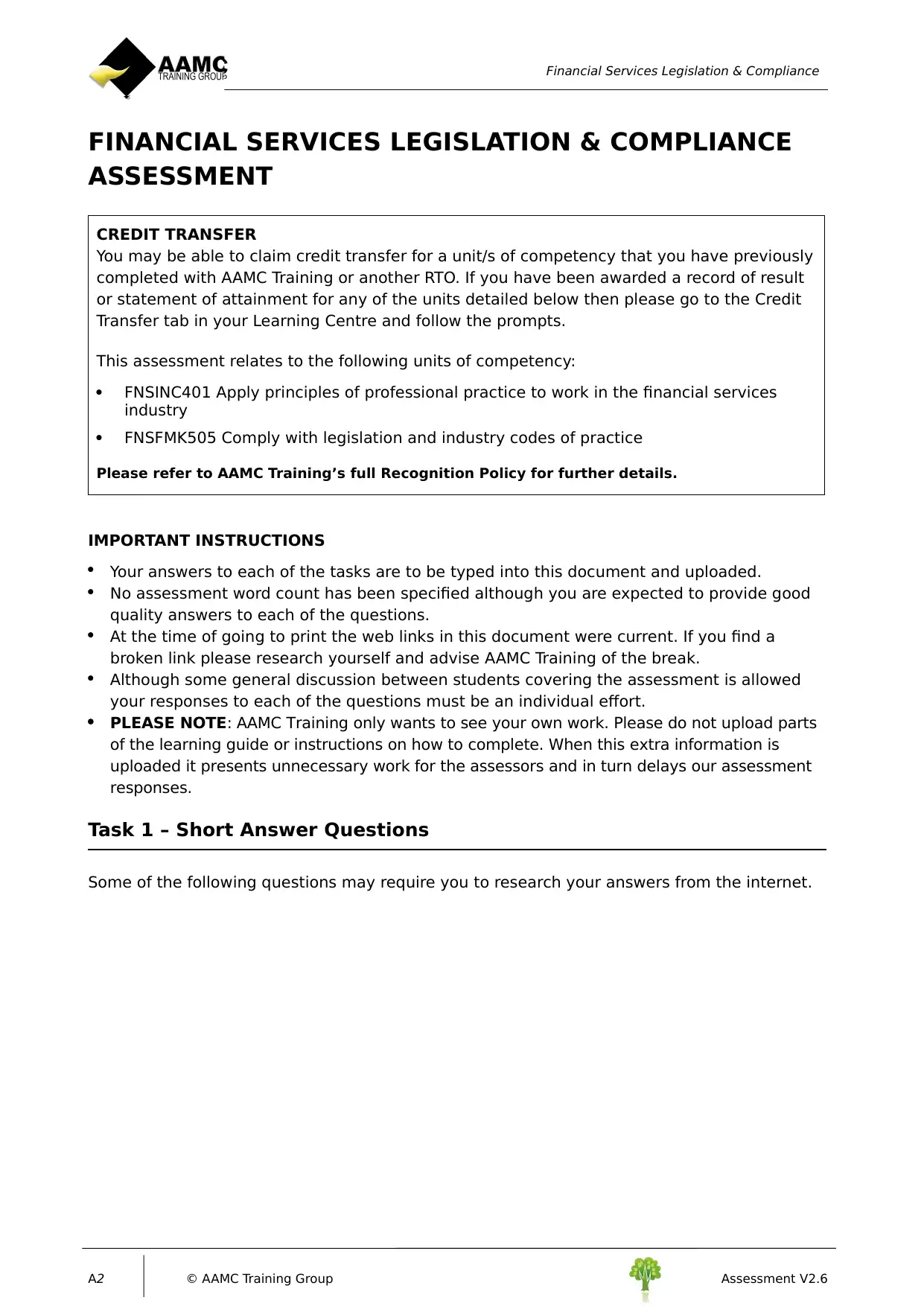
Financial Services Legislation & Compliance
FINANCIAL SERVICES LEGISLATION & COMPLIANCE
ASSESSMENT
CREDIT TRANSFER
You may be able to claim credit transfer for a unit/s of competency that you have previously
completed with AAMC Training or another RTO. If you have been awarded a record of result
or statement of attainment for any of the units detailed below then please go to the Credit
Transfer tab in your Learning Centre and follow the prompts.
This assessment relates to the following units of competency:
FNSINC401 Apply principles of professional practice to work in the financial services
industry
FNSFMK505 Comply with legislation and industry codes of practice
Please refer to AAMC Training’s full Recognition Policy for further details.
IMPORTANT INSTRUCTIONS
Your answers to each of the tasks are to be typed into this document and uploaded.
No assessment word count has been specified although you are expected to provide good
quality answers to each of the questions.
At the time of going to print the web links in this document were current. If you find a
broken link please research yourself and advise AAMC Training of the break.
Although some general discussion between students covering the assessment is allowed
your responses to each of the questions must be an individual effort.
PLEASE NOTE: AAMC Training only wants to see your own work. Please do not upload parts
of the learning guide or instructions on how to complete. When this extra information is
uploaded it presents unnecessary work for the assessors and in turn delays our assessment
responses.
Task 1 – Short Answer Questions
Some of the following questions may require you to research your answers from the internet.
A2 © AAMC Training Group Assessment V2.6
FINANCIAL SERVICES LEGISLATION & COMPLIANCE
ASSESSMENT
CREDIT TRANSFER
You may be able to claim credit transfer for a unit/s of competency that you have previously
completed with AAMC Training or another RTO. If you have been awarded a record of result
or statement of attainment for any of the units detailed below then please go to the Credit
Transfer tab in your Learning Centre and follow the prompts.
This assessment relates to the following units of competency:
FNSINC401 Apply principles of professional practice to work in the financial services
industry
FNSFMK505 Comply with legislation and industry codes of practice
Please refer to AAMC Training’s full Recognition Policy for further details.
IMPORTANT INSTRUCTIONS
Your answers to each of the tasks are to be typed into this document and uploaded.
No assessment word count has been specified although you are expected to provide good
quality answers to each of the questions.
At the time of going to print the web links in this document were current. If you find a
broken link please research yourself and advise AAMC Training of the break.
Although some general discussion between students covering the assessment is allowed
your responses to each of the questions must be an individual effort.
PLEASE NOTE: AAMC Training only wants to see your own work. Please do not upload parts
of the learning guide or instructions on how to complete. When this extra information is
uploaded it presents unnecessary work for the assessors and in turn delays our assessment
responses.
Task 1 – Short Answer Questions
Some of the following questions may require you to research your answers from the internet.
A2 © AAMC Training Group Assessment V2.6
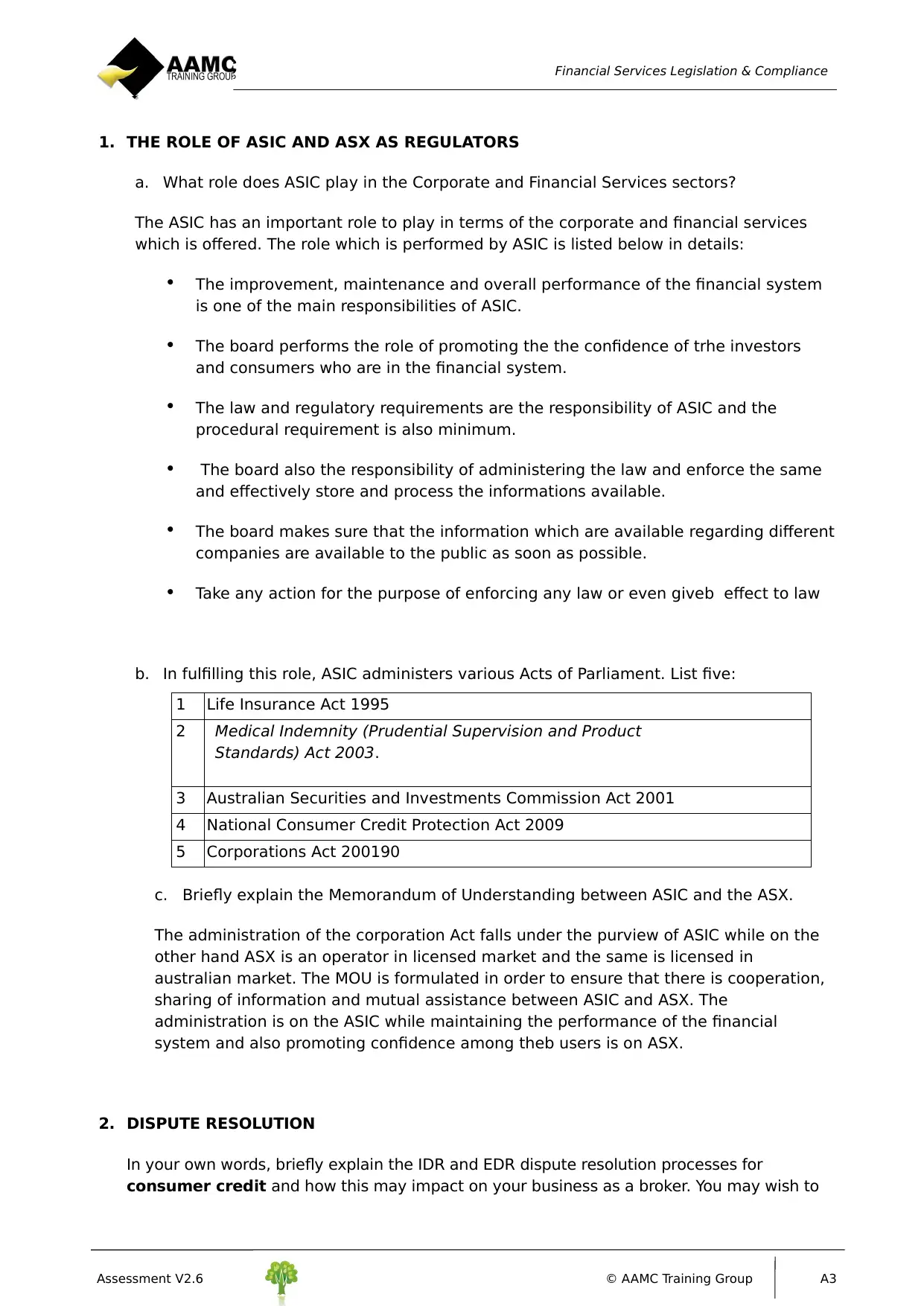
Financial Services Legislation & Compliance
1. THE ROLE OF ASIC AND ASX AS REGULATORS
a. What role does ASIC play in the Corporate and Financial Services sectors?
The ASIC has an important role to play in terms of the corporate and financial services
which is offered. The role which is performed by ASIC is listed below in details:
The improvement, maintenance and overall performance of the financial system
is one of the main responsibilities of ASIC.
The board performs the role of promoting the the confidence of trhe investors
and consumers who are in the financial system.
The law and regulatory requirements are the responsibility of ASIC and the
procedural requirement is also minimum.
The board also the responsibility of administering the law and enforce the same
and effectively store and process the informations available.
The board makes sure that the information which are available regarding different
companies are available to the public as soon as possible.
Take any action for the purpose of enforcing any law or even giveb effect to law
b. In fulfilling this role, ASIC administers various Acts of Parliament. List five:
1 Life Insurance Act 1995
2 Medical Indemnity (Prudential Supervision and Product
Standards) Act 2003.
3 Australian Securities and Investments Commission Act 2001
4 National Consumer Credit Protection Act 2009
5 Corporations Act 200190
c. Briefly explain the Memorandum of Understanding between ASIC and the ASX.
The administration of the corporation Act falls under the purview of ASIC while on the
other hand ASX is an operator in licensed market and the same is licensed in
australian market. The MOU is formulated in order to ensure that there is cooperation,
sharing of information and mutual assistance between ASIC and ASX. The
administration is on the ASIC while maintaining the performance of the financial
system and also promoting confidence among theb users is on ASX.
2. DISPUTE RESOLUTION
In your own words, briefly explain the IDR and EDR dispute resolution processes for
consumer credit and how this may impact on your business as a broker. You may wish to
Assessment V2.6 © AAMC Training Group A3
1. THE ROLE OF ASIC AND ASX AS REGULATORS
a. What role does ASIC play in the Corporate and Financial Services sectors?
The ASIC has an important role to play in terms of the corporate and financial services
which is offered. The role which is performed by ASIC is listed below in details:
The improvement, maintenance and overall performance of the financial system
is one of the main responsibilities of ASIC.
The board performs the role of promoting the the confidence of trhe investors
and consumers who are in the financial system.
The law and regulatory requirements are the responsibility of ASIC and the
procedural requirement is also minimum.
The board also the responsibility of administering the law and enforce the same
and effectively store and process the informations available.
The board makes sure that the information which are available regarding different
companies are available to the public as soon as possible.
Take any action for the purpose of enforcing any law or even giveb effect to law
b. In fulfilling this role, ASIC administers various Acts of Parliament. List five:
1 Life Insurance Act 1995
2 Medical Indemnity (Prudential Supervision and Product
Standards) Act 2003.
3 Australian Securities and Investments Commission Act 2001
4 National Consumer Credit Protection Act 2009
5 Corporations Act 200190
c. Briefly explain the Memorandum of Understanding between ASIC and the ASX.
The administration of the corporation Act falls under the purview of ASIC while on the
other hand ASX is an operator in licensed market and the same is licensed in
australian market. The MOU is formulated in order to ensure that there is cooperation,
sharing of information and mutual assistance between ASIC and ASX. The
administration is on the ASIC while maintaining the performance of the financial
system and also promoting confidence among theb users is on ASX.
2. DISPUTE RESOLUTION
In your own words, briefly explain the IDR and EDR dispute resolution processes for
consumer credit and how this may impact on your business as a broker. You may wish to
Assessment V2.6 © AAMC Training Group A3
⊘ This is a preview!⊘
Do you want full access?
Subscribe today to unlock all pages.

Trusted by 1+ million students worldwide
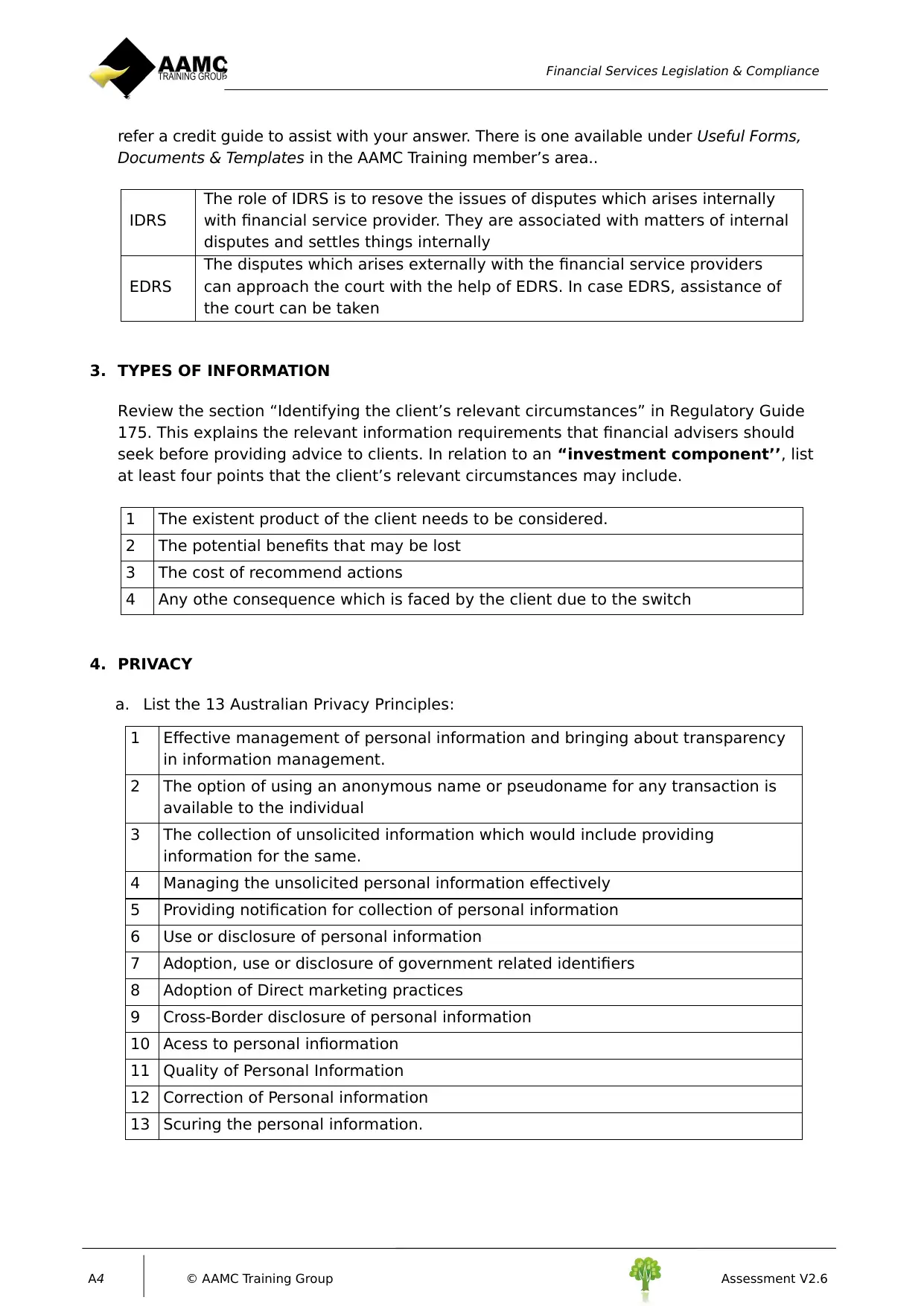
Financial Services Legislation & Compliance
refer a credit guide to assist with your answer. There is one available under Useful Forms,
Documents & Templates in the AAMC Training member’s area..
IDRS
The role of IDRS is to resove the issues of disputes which arises internally
with financial service provider. They are associated with matters of internal
disputes and settles things internally
EDRS
The disputes which arises externally with the financial service providers
can approach the court with the help of EDRS. In case EDRS, assistance of
the court can be taken
3. TYPES OF INFORMATION
Review the section “Identifying the client’s relevant circumstances” in Regulatory Guide
175. This explains the relevant information requirements that financial advisers should
seek before providing advice to clients. In relation to an “investment component’’, list
at least four points that the client’s relevant circumstances may include.
1 The existent product of the client needs to be considered.
2 The potential benefits that may be lost
3 The cost of recommend actions
4 Any othe consequence which is faced by the client due to the switch
4. PRIVACY
a. List the 13 Australian Privacy Principles:
1 Effective management of personal information and bringing about transparency
in information management.
2 The option of using an anonymous name or pseudoname for any transaction is
available to the individual
3 The collection of unsolicited information which would include providing
information for the same.
4 Managing the unsolicited personal information effectively
5 Providing notification for collection of personal information
6 Use or disclosure of personal information
7 Adoption, use or disclosure of government related identifiers
8 Adoption of Direct marketing practices
9 Cross-Border disclosure of personal information
10 Acess to personal infiormation
11 Quality of Personal Information
12 Correction of Personal information
13 Scuring the personal information.
A4 © AAMC Training Group Assessment V2.6
refer a credit guide to assist with your answer. There is one available under Useful Forms,
Documents & Templates in the AAMC Training member’s area..
IDRS
The role of IDRS is to resove the issues of disputes which arises internally
with financial service provider. They are associated with matters of internal
disputes and settles things internally
EDRS
The disputes which arises externally with the financial service providers
can approach the court with the help of EDRS. In case EDRS, assistance of
the court can be taken
3. TYPES OF INFORMATION
Review the section “Identifying the client’s relevant circumstances” in Regulatory Guide
175. This explains the relevant information requirements that financial advisers should
seek before providing advice to clients. In relation to an “investment component’’, list
at least four points that the client’s relevant circumstances may include.
1 The existent product of the client needs to be considered.
2 The potential benefits that may be lost
3 The cost of recommend actions
4 Any othe consequence which is faced by the client due to the switch
4. PRIVACY
a. List the 13 Australian Privacy Principles:
1 Effective management of personal information and bringing about transparency
in information management.
2 The option of using an anonymous name or pseudoname for any transaction is
available to the individual
3 The collection of unsolicited information which would include providing
information for the same.
4 Managing the unsolicited personal information effectively
5 Providing notification for collection of personal information
6 Use or disclosure of personal information
7 Adoption, use or disclosure of government related identifiers
8 Adoption of Direct marketing practices
9 Cross-Border disclosure of personal information
10 Acess to personal infiormation
11 Quality of Personal Information
12 Correction of Personal information
13 Scuring the personal information.
A4 © AAMC Training Group Assessment V2.6
Paraphrase This Document
Need a fresh take? Get an instant paraphrase of this document with our AI Paraphraser
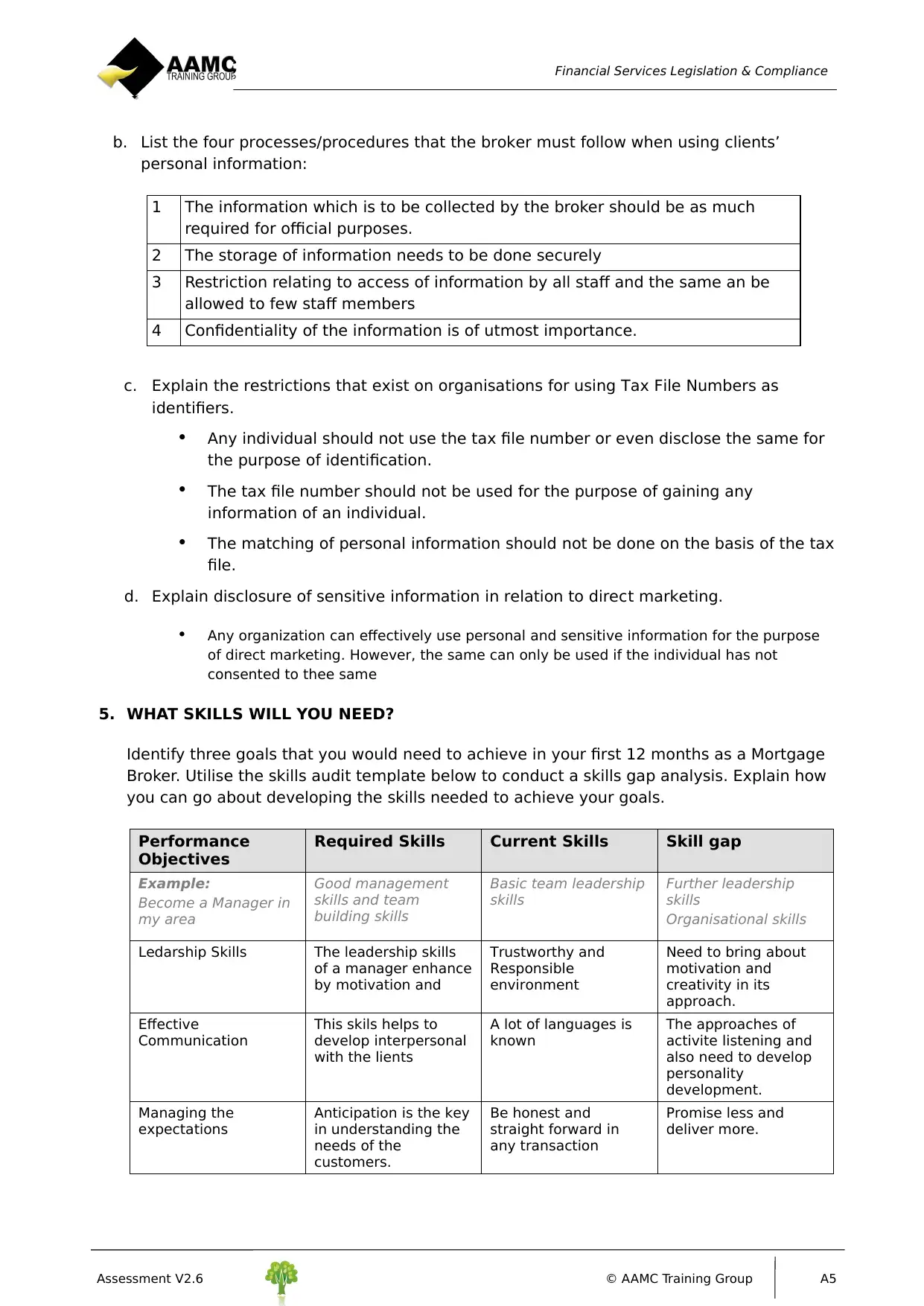
Financial Services Legislation & Compliance
b. List the four processes/procedures that the broker must follow when using clients’
personal information:
1 The information which is to be collected by the broker should be as much
required for official purposes.
2 The storage of information needs to be done securely
3 Restriction relating to access of information by all staff and the same an be
allowed to few staff members
4 Confidentiality of the information is of utmost importance.
c. Explain the restrictions that exist on organisations for using Tax File Numbers as
identifiers.
Any individual should not use the tax file number or even disclose the same for
the purpose of identification.
The tax file number should not be used for the purpose of gaining any
information of an individual.
The matching of personal information should not be done on the basis of the tax
file.
d. Explain disclosure of sensitive information in relation to direct marketing.
Any organization can effectively use personal and sensitive information for the purpose
of direct marketing. However, the same can only be used if the individual has not
consented to thee same
5. WHAT SKILLS WILL YOU NEED?
Identify three goals that you would need to achieve in your first 12 months as a Mortgage
Broker. Utilise the skills audit template below to conduct a skills gap analysis. Explain how
you can go about developing the skills needed to achieve your goals.
Performance
Objectives
Required Skills Current Skills Skill gap
Example:
Become a Manager in
my area
Good management
skills and team
building skills
Basic team leadership
skills
Further leadership
skills
Organisational skills
Ledarship Skills The leadership skills
of a manager enhance
by motivation and
Trustworthy and
Responsible
environment
Need to bring about
motivation and
creativity in its
approach.
Effective
Communication
This skils helps to
develop interpersonal
with the lients
A lot of languages is
known
The approaches of
activite listening and
also need to develop
personality
development.
Managing the
expectations
Anticipation is the key
in understanding the
needs of the
customers.
Be honest and
straight forward in
any transaction
Promise less and
deliver more.
Assessment V2.6 © AAMC Training Group A5
b. List the four processes/procedures that the broker must follow when using clients’
personal information:
1 The information which is to be collected by the broker should be as much
required for official purposes.
2 The storage of information needs to be done securely
3 Restriction relating to access of information by all staff and the same an be
allowed to few staff members
4 Confidentiality of the information is of utmost importance.
c. Explain the restrictions that exist on organisations for using Tax File Numbers as
identifiers.
Any individual should not use the tax file number or even disclose the same for
the purpose of identification.
The tax file number should not be used for the purpose of gaining any
information of an individual.
The matching of personal information should not be done on the basis of the tax
file.
d. Explain disclosure of sensitive information in relation to direct marketing.
Any organization can effectively use personal and sensitive information for the purpose
of direct marketing. However, the same can only be used if the individual has not
consented to thee same
5. WHAT SKILLS WILL YOU NEED?
Identify three goals that you would need to achieve in your first 12 months as a Mortgage
Broker. Utilise the skills audit template below to conduct a skills gap analysis. Explain how
you can go about developing the skills needed to achieve your goals.
Performance
Objectives
Required Skills Current Skills Skill gap
Example:
Become a Manager in
my area
Good management
skills and team
building skills
Basic team leadership
skills
Further leadership
skills
Organisational skills
Ledarship Skills The leadership skills
of a manager enhance
by motivation and
Trustworthy and
Responsible
environment
Need to bring about
motivation and
creativity in its
approach.
Effective
Communication
This skils helps to
develop interpersonal
with the lients
A lot of languages is
known
The approaches of
activite listening and
also need to develop
personality
development.
Managing the
expectations
Anticipation is the key
in understanding the
needs of the
customers.
Be honest and
straight forward in
any transaction
Promise less and
deliver more.
Assessment V2.6 © AAMC Training Group A5
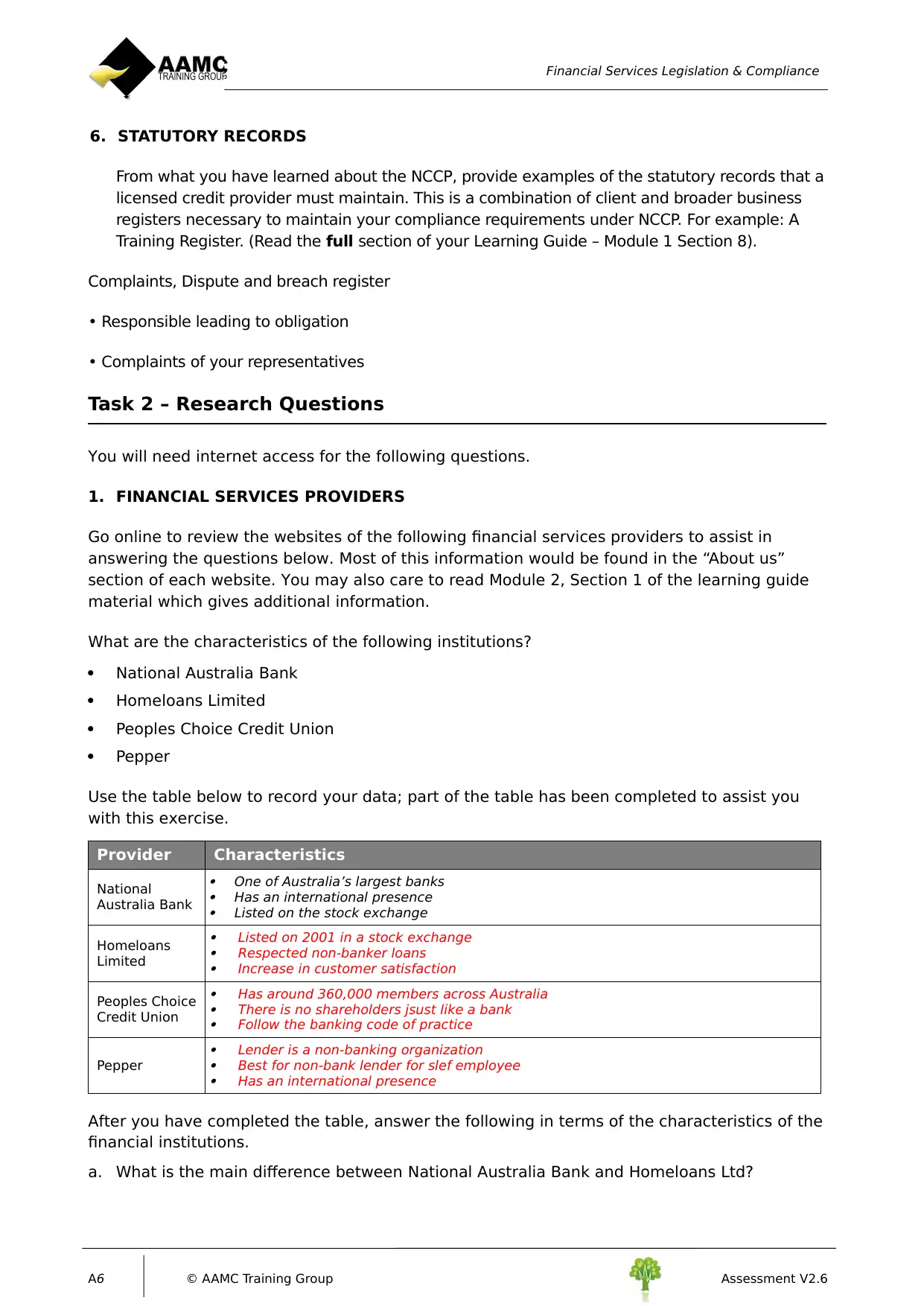
Financial Services Legislation & Compliance
6. STATUTORY RECORDS
From what you have learned about the NCCP, provide examples of the statutory records that a
licensed credit provider must maintain. This is a combination of client and broader business
registers necessary to maintain your compliance requirements under NCCP. For example: A
Training Register. (Read the full section of your Learning Guide – Module 1 Section 8).
Complaints, Dispute and breach register
• Responsible leading to obligation
• Complaints of your representatives
Task 2 – Research Questions
You will need internet access for the following questions.
1. FINANCIAL SERVICES PROVIDERS
Go online to review the websites of the following financial services providers to assist in
answering the questions below. Most of this information would be found in the “About us”
section of each website. You may also care to read Module 2, Section 1 of the learning guide
material which gives additional information.
What are the characteristics of the following institutions?
National Australia Bank
Homeloans Limited
Peoples Choice Credit Union
Pepper
Use the table below to record your data; part of the table has been completed to assist you
with this exercise.
Provider Characteristics
National
Australia Bank
One of Australia’s largest banks
Has an international presence
Listed on the stock exchange
Homeloans
Limited
Listed on 2001 in a stock exchange
Respected non-banker loans
Increase in customer satisfaction
Peoples Choice
Credit Union
Has around 360,000 members across Australia
There is no shareholders jsust like a bank
Follow the banking code of practice
Pepper
Lender is a non-banking organization
Best for non-bank lender for slef employee
Has an international presence
After you have completed the table, answer the following in terms of the characteristics of the
financial institutions.
a. What is the main difference between National Australia Bank and Homeloans Ltd?
A6 © AAMC Training Group Assessment V2.6
6. STATUTORY RECORDS
From what you have learned about the NCCP, provide examples of the statutory records that a
licensed credit provider must maintain. This is a combination of client and broader business
registers necessary to maintain your compliance requirements under NCCP. For example: A
Training Register. (Read the full section of your Learning Guide – Module 1 Section 8).
Complaints, Dispute and breach register
• Responsible leading to obligation
• Complaints of your representatives
Task 2 – Research Questions
You will need internet access for the following questions.
1. FINANCIAL SERVICES PROVIDERS
Go online to review the websites of the following financial services providers to assist in
answering the questions below. Most of this information would be found in the “About us”
section of each website. You may also care to read Module 2, Section 1 of the learning guide
material which gives additional information.
What are the characteristics of the following institutions?
National Australia Bank
Homeloans Limited
Peoples Choice Credit Union
Pepper
Use the table below to record your data; part of the table has been completed to assist you
with this exercise.
Provider Characteristics
National
Australia Bank
One of Australia’s largest banks
Has an international presence
Listed on the stock exchange
Homeloans
Limited
Listed on 2001 in a stock exchange
Respected non-banker loans
Increase in customer satisfaction
Peoples Choice
Credit Union
Has around 360,000 members across Australia
There is no shareholders jsust like a bank
Follow the banking code of practice
Pepper
Lender is a non-banking organization
Best for non-bank lender for slef employee
Has an international presence
After you have completed the table, answer the following in terms of the characteristics of the
financial institutions.
a. What is the main difference between National Australia Bank and Homeloans Ltd?
A6 © AAMC Training Group Assessment V2.6
⊘ This is a preview!⊘
Do you want full access?
Subscribe today to unlock all pages.

Trusted by 1+ million students worldwide
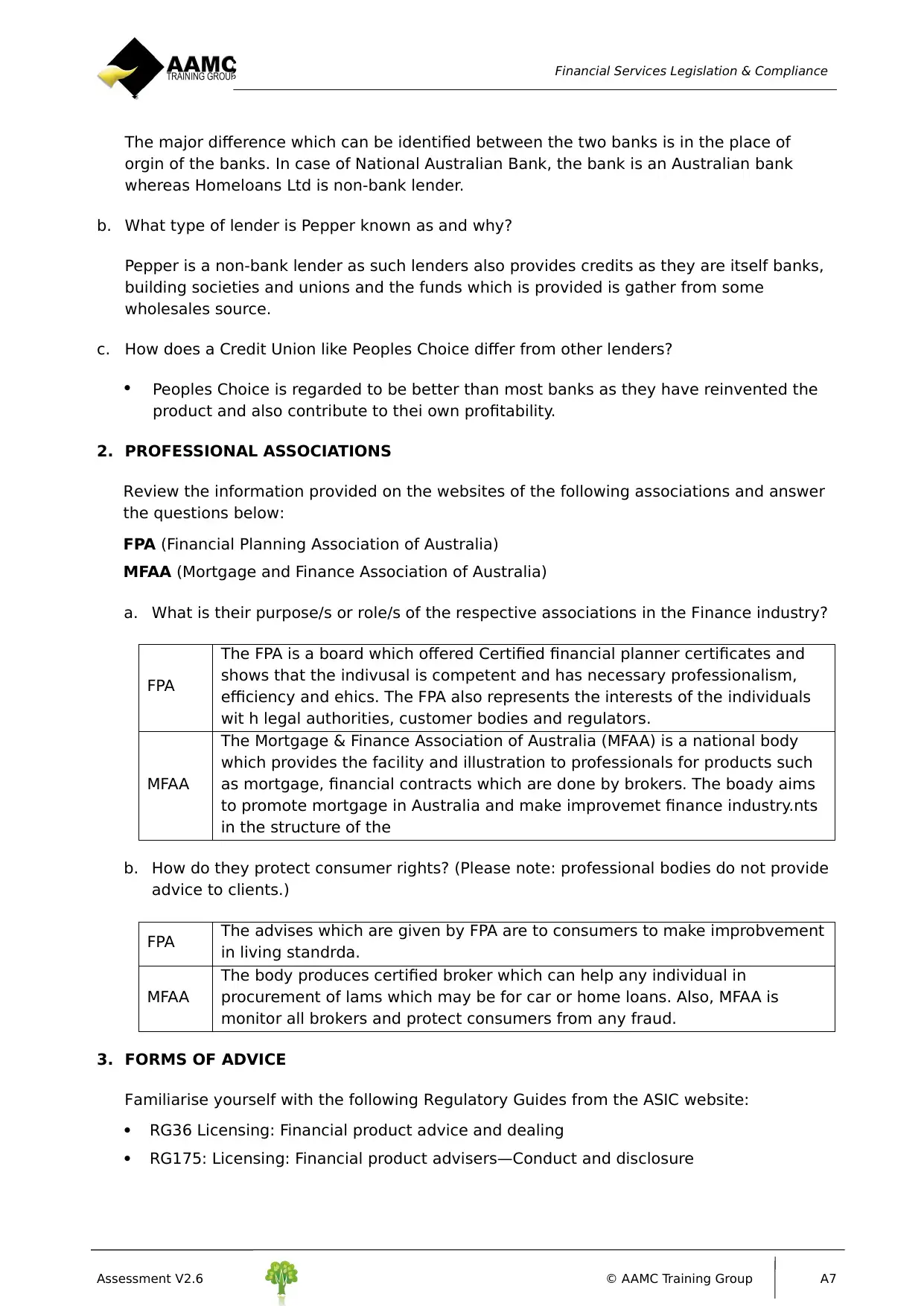
Financial Services Legislation & Compliance
The major difference which can be identified between the two banks is in the place of
orgin of the banks. In case of National Australian Bank, the bank is an Australian bank
whereas Homeloans Ltd is non-bank lender.
b. What type of lender is Pepper known as and why?
Pepper is a non-bank lender as such lenders also provides credits as they are itself banks,
building societies and unions and the funds which is provided is gather from some
wholesales source.
c. How does a Credit Union like Peoples Choice differ from other lenders?
Peoples Choice is regarded to be better than most banks as they have reinvented the
product and also contribute to thei own profitability.
2. PROFESSIONAL ASSOCIATIONS
Review the information provided on the websites of the following associations and answer
the questions below:
FPA (Financial Planning Association of Australia)
MFAA (Mortgage and Finance Association of Australia)
a. What is their purpose/s or role/s of the respective associations in the Finance industry?
FPA
The FPA is a board which offered Certified financial planner certificates and
shows that the indivusal is competent and has necessary professionalism,
efficiency and ehics. The FPA also represents the interests of the individuals
wit h legal authorities, customer bodies and regulators.
MFAA
The Mortgage & Finance Association of Australia (MFAA) is a national body
which provides the facility and illustration to professionals for products such
as mortgage, financial contracts which are done by brokers. The boady aims
to promote mortgage in Australia and make improvemet finance industry.nts
in the structure of the
b. How do they protect consumer rights? (Please note: professional bodies do not provide
advice to clients.)
FPA The advises which are given by FPA are to consumers to make improbvement
in living standrda.
MFAA
The body produces certified broker which can help any individual in
procurement of lams which may be for car or home loans. Also, MFAA is
monitor all brokers and protect consumers from any fraud.
3. FORMS OF ADVICE
Familiarise yourself with the following Regulatory Guides from the ASIC website:
RG36 Licensing: Financial product advice and dealing
RG175: Licensing: Financial product advisers—Conduct and disclosure
Assessment V2.6 © AAMC Training Group A7
The major difference which can be identified between the two banks is in the place of
orgin of the banks. In case of National Australian Bank, the bank is an Australian bank
whereas Homeloans Ltd is non-bank lender.
b. What type of lender is Pepper known as and why?
Pepper is a non-bank lender as such lenders also provides credits as they are itself banks,
building societies and unions and the funds which is provided is gather from some
wholesales source.
c. How does a Credit Union like Peoples Choice differ from other lenders?
Peoples Choice is regarded to be better than most banks as they have reinvented the
product and also contribute to thei own profitability.
2. PROFESSIONAL ASSOCIATIONS
Review the information provided on the websites of the following associations and answer
the questions below:
FPA (Financial Planning Association of Australia)
MFAA (Mortgage and Finance Association of Australia)
a. What is their purpose/s or role/s of the respective associations in the Finance industry?
FPA
The FPA is a board which offered Certified financial planner certificates and
shows that the indivusal is competent and has necessary professionalism,
efficiency and ehics. The FPA also represents the interests of the individuals
wit h legal authorities, customer bodies and regulators.
MFAA
The Mortgage & Finance Association of Australia (MFAA) is a national body
which provides the facility and illustration to professionals for products such
as mortgage, financial contracts which are done by brokers. The boady aims
to promote mortgage in Australia and make improvemet finance industry.nts
in the structure of the
b. How do they protect consumer rights? (Please note: professional bodies do not provide
advice to clients.)
FPA The advises which are given by FPA are to consumers to make improbvement
in living standrda.
MFAA
The body produces certified broker which can help any individual in
procurement of lams which may be for car or home loans. Also, MFAA is
monitor all brokers and protect consumers from any fraud.
3. FORMS OF ADVICE
Familiarise yourself with the following Regulatory Guides from the ASIC website:
RG36 Licensing: Financial product advice and dealing
RG175: Licensing: Financial product advisers—Conduct and disclosure
Assessment V2.6 © AAMC Training Group A7
Paraphrase This Document
Need a fresh take? Get an instant paraphrase of this document with our AI Paraphraser
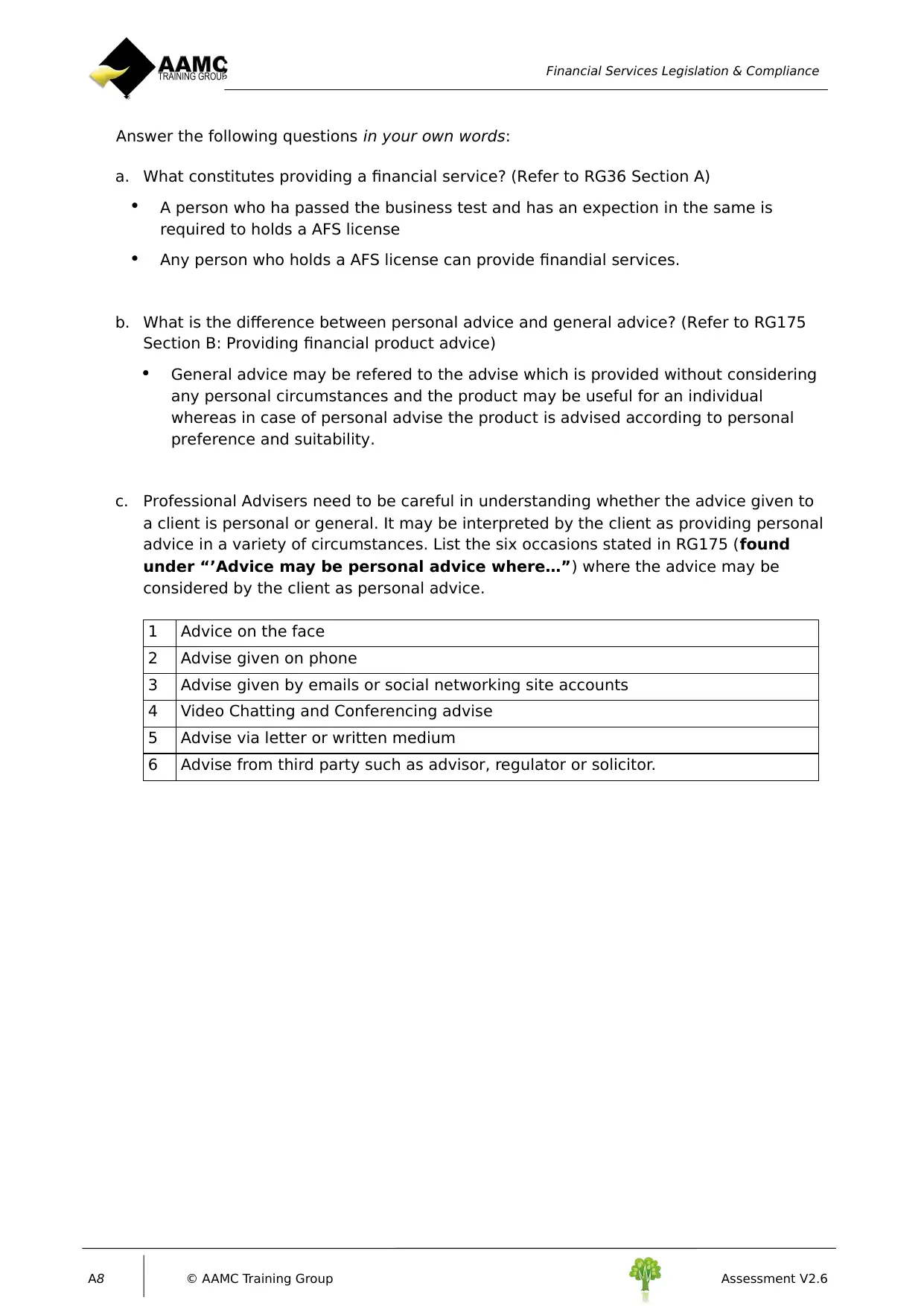
Financial Services Legislation & Compliance
Answer the following questions in your own words:
a. What constitutes providing a financial service? (Refer to RG36 Section A)
A person who ha passed the business test and has an expection in the same is
required to holds a AFS license
Any person who holds a AFS license can provide finandial services.
b. What is the difference between personal advice and general advice? (Refer to RG175
Section B: Providing financial product advice)
General advice may be refered to the advise which is provided without considering
any personal circumstances and the product may be useful for an individual
whereas in case of personal advise the product is advised according to personal
preference and suitability.
c. Professional Advisers need to be careful in understanding whether the advice given to
a client is personal or general. It may be interpreted by the client as providing personal
advice in a variety of circumstances. List the six occasions stated in RG175 (found
under “’Advice may be personal advice where…”) where the advice may be
considered by the client as personal advice.
1 Advice on the face
2 Advise given on phone
3 Advise given by emails or social networking site accounts
4 Video Chatting and Conferencing advise
5 Advise via letter or written medium
6 Advise from third party such as advisor, regulator or solicitor.
A8 © AAMC Training Group Assessment V2.6
Answer the following questions in your own words:
a. What constitutes providing a financial service? (Refer to RG36 Section A)
A person who ha passed the business test and has an expection in the same is
required to holds a AFS license
Any person who holds a AFS license can provide finandial services.
b. What is the difference between personal advice and general advice? (Refer to RG175
Section B: Providing financial product advice)
General advice may be refered to the advise which is provided without considering
any personal circumstances and the product may be useful for an individual
whereas in case of personal advise the product is advised according to personal
preference and suitability.
c. Professional Advisers need to be careful in understanding whether the advice given to
a client is personal or general. It may be interpreted by the client as providing personal
advice in a variety of circumstances. List the six occasions stated in RG175 (found
under “’Advice may be personal advice where…”) where the advice may be
considered by the client as personal advice.
1 Advice on the face
2 Advise given on phone
3 Advise given by emails or social networking site accounts
4 Video Chatting and Conferencing advise
5 Advise via letter or written medium
6 Advise from third party such as advisor, regulator or solicitor.
A8 © AAMC Training Group Assessment V2.6
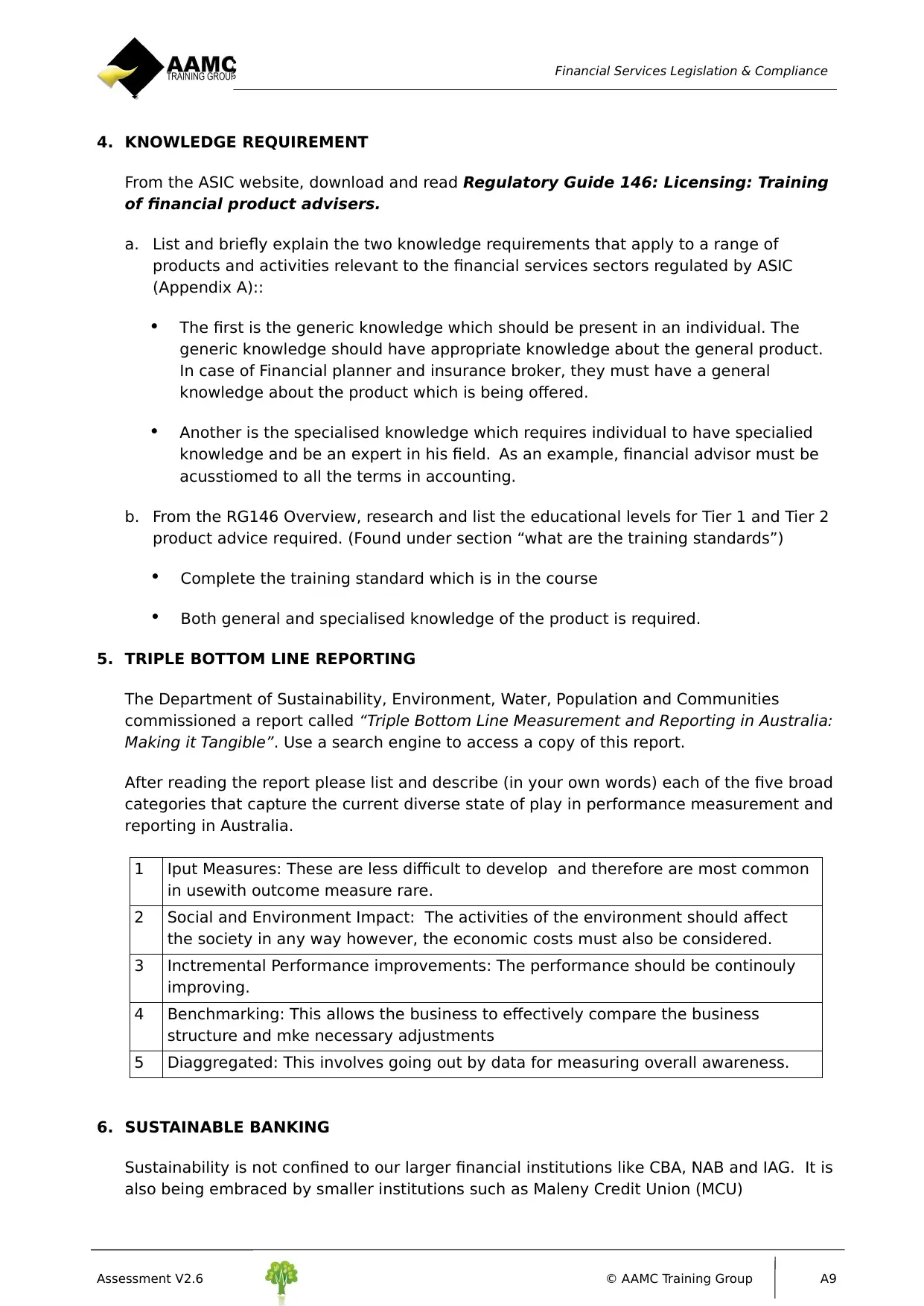
Financial Services Legislation & Compliance
4. KNOWLEDGE REQUIREMENT
From the ASIC website, download and read Regulatory Guide 146: Licensing: Training
of financial product advisers.
a. List and briefly explain the two knowledge requirements that apply to a range of
products and activities relevant to the financial services sectors regulated by ASIC
(Appendix A)::
The first is the generic knowledge which should be present in an individual. The
generic knowledge should have appropriate knowledge about the general product.
In case of Financial planner and insurance broker, they must have a general
knowledge about the product which is being offered.
Another is the specialised knowledge which requires individual to have specialied
knowledge and be an expert in his field. As an example, financial advisor must be
acusstiomed to all the terms in accounting.
b. From the RG146 Overview, research and list the educational levels for Tier 1 and Tier 2
product advice required. (Found under section “what are the training standards”)
Complete the training standard which is in the course
Both general and specialised knowledge of the product is required.
5. TRIPLE BOTTOM LINE REPORTING
The Department of Sustainability, Environment, Water, Population and Communities
commissioned a report called “Triple Bottom Line Measurement and Reporting in Australia:
Making it Tangible”. Use a search engine to access a copy of this report.
After reading the report please list and describe (in your own words) each of the five broad
categories that capture the current diverse state of play in performance measurement and
reporting in Australia.
1 Iput Measures: These are less difficult to develop and therefore are most common
in usewith outcome measure rare.
2 Social and Environment Impact: The activities of the environment should affect
the society in any way however, the economic costs must also be considered.
3 Inctremental Performance improvements: The performance should be continouly
improving.
4 Benchmarking: This allows the business to effectively compare the business
structure and mke necessary adjustments
5 Diaggregated: This involves going out by data for measuring overall awareness.
6. SUSTAINABLE BANKING
Sustainability is not confined to our larger financial institutions like CBA, NAB and IAG. It is
also being embraced by smaller institutions such as Maleny Credit Union (MCU)
Assessment V2.6 © AAMC Training Group A9
4. KNOWLEDGE REQUIREMENT
From the ASIC website, download and read Regulatory Guide 146: Licensing: Training
of financial product advisers.
a. List and briefly explain the two knowledge requirements that apply to a range of
products and activities relevant to the financial services sectors regulated by ASIC
(Appendix A)::
The first is the generic knowledge which should be present in an individual. The
generic knowledge should have appropriate knowledge about the general product.
In case of Financial planner and insurance broker, they must have a general
knowledge about the product which is being offered.
Another is the specialised knowledge which requires individual to have specialied
knowledge and be an expert in his field. As an example, financial advisor must be
acusstiomed to all the terms in accounting.
b. From the RG146 Overview, research and list the educational levels for Tier 1 and Tier 2
product advice required. (Found under section “what are the training standards”)
Complete the training standard which is in the course
Both general and specialised knowledge of the product is required.
5. TRIPLE BOTTOM LINE REPORTING
The Department of Sustainability, Environment, Water, Population and Communities
commissioned a report called “Triple Bottom Line Measurement and Reporting in Australia:
Making it Tangible”. Use a search engine to access a copy of this report.
After reading the report please list and describe (in your own words) each of the five broad
categories that capture the current diverse state of play in performance measurement and
reporting in Australia.
1 Iput Measures: These are less difficult to develop and therefore are most common
in usewith outcome measure rare.
2 Social and Environment Impact: The activities of the environment should affect
the society in any way however, the economic costs must also be considered.
3 Inctremental Performance improvements: The performance should be continouly
improving.
4 Benchmarking: This allows the business to effectively compare the business
structure and mke necessary adjustments
5 Diaggregated: This involves going out by data for measuring overall awareness.
6. SUSTAINABLE BANKING
Sustainability is not confined to our larger financial institutions like CBA, NAB and IAG. It is
also being embraced by smaller institutions such as Maleny Credit Union (MCU)
Assessment V2.6 © AAMC Training Group A9
⊘ This is a preview!⊘
Do you want full access?
Subscribe today to unlock all pages.

Trusted by 1+ million students worldwide
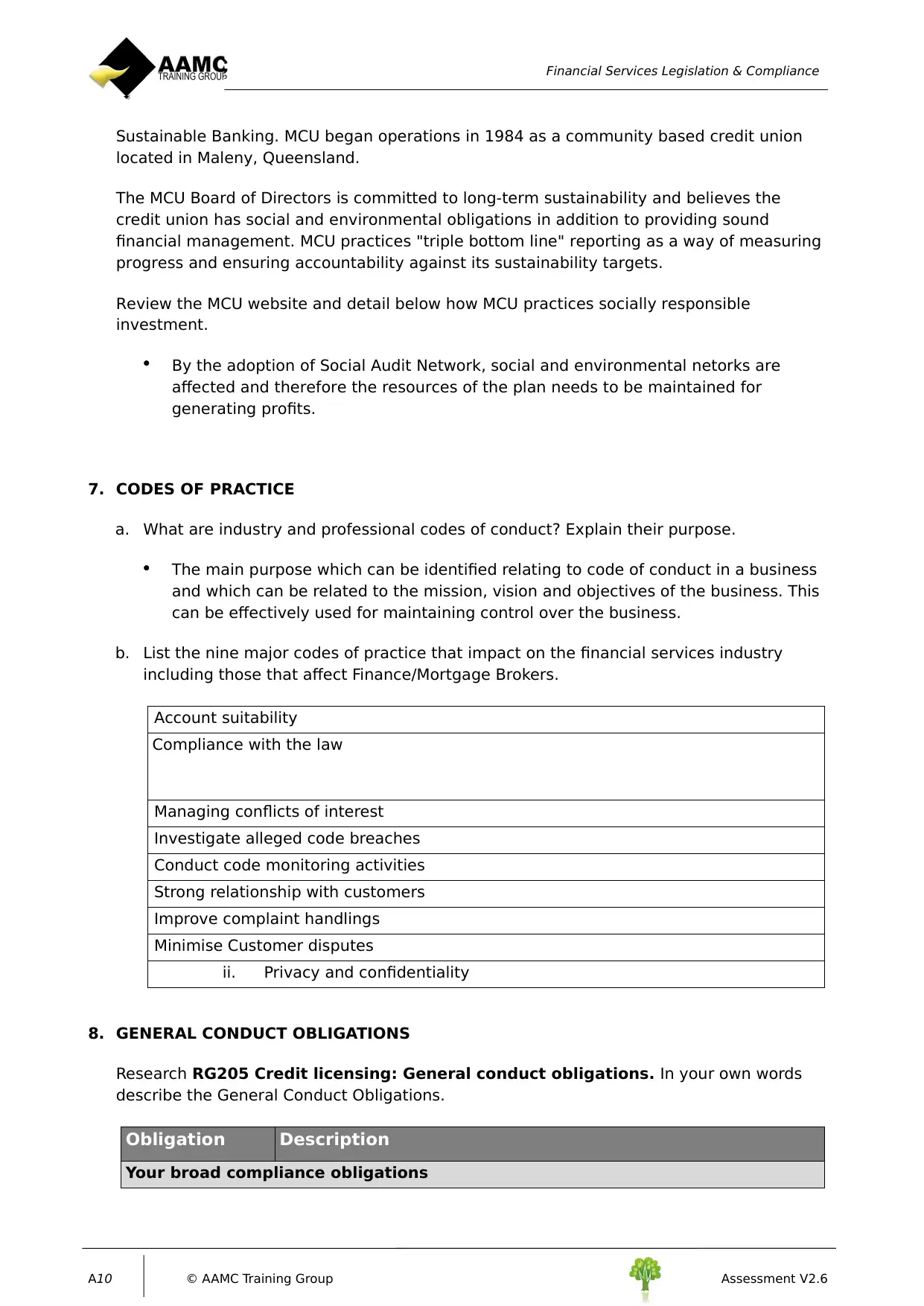
Financial Services Legislation & Compliance
Sustainable Banking. MCU began operations in 1984 as a community based credit union
located in Maleny, Queensland.
The MCU Board of Directors is committed to long-term sustainability and believes the
credit union has social and environmental obligations in addition to providing sound
financial management. MCU practices "triple bottom line" reporting as a way of measuring
progress and ensuring accountability against its sustainability targets.
Review the MCU website and detail below how MCU practices socially responsible
investment.
By the adoption of Social Audit Network, social and environmental netorks are
affected and therefore the resources of the plan needs to be maintained for
generating profits.
7. CODES OF PRACTICE
a. What are industry and professional codes of conduct? Explain their purpose.
The main purpose which can be identified relating to code of conduct in a business
and which can be related to the mission, vision and objectives of the business. This
can be effectively used for maintaining control over the business.
b. List the nine major codes of practice that impact on the financial services industry
including those that affect Finance/Mortgage Brokers.
Account suitability
Compliance with the law
Managing conflicts of interest
Investigate alleged code breaches
Conduct code monitoring activities
Strong relationship with customers
Improve complaint handlings
Minimise Customer disputes
ii. Privacy and confidentiality
8. GENERAL CONDUCT OBLIGATIONS
Research RG205 Credit licensing: General conduct obligations. In your own words
describe the General Conduct Obligations.
Obligation Description
Your broad compliance obligations
A10 © AAMC Training Group Assessment V2.6
Sustainable Banking. MCU began operations in 1984 as a community based credit union
located in Maleny, Queensland.
The MCU Board of Directors is committed to long-term sustainability and believes the
credit union has social and environmental obligations in addition to providing sound
financial management. MCU practices "triple bottom line" reporting as a way of measuring
progress and ensuring accountability against its sustainability targets.
Review the MCU website and detail below how MCU practices socially responsible
investment.
By the adoption of Social Audit Network, social and environmental netorks are
affected and therefore the resources of the plan needs to be maintained for
generating profits.
7. CODES OF PRACTICE
a. What are industry and professional codes of conduct? Explain their purpose.
The main purpose which can be identified relating to code of conduct in a business
and which can be related to the mission, vision and objectives of the business. This
can be effectively used for maintaining control over the business.
b. List the nine major codes of practice that impact on the financial services industry
including those that affect Finance/Mortgage Brokers.
Account suitability
Compliance with the law
Managing conflicts of interest
Investigate alleged code breaches
Conduct code monitoring activities
Strong relationship with customers
Improve complaint handlings
Minimise Customer disputes
ii. Privacy and confidentiality
8. GENERAL CONDUCT OBLIGATIONS
Research RG205 Credit licensing: General conduct obligations. In your own words
describe the General Conduct Obligations.
Obligation Description
Your broad compliance obligations
A10 © AAMC Training Group Assessment V2.6
Paraphrase This Document
Need a fresh take? Get an instant paraphrase of this document with our AI Paraphraser
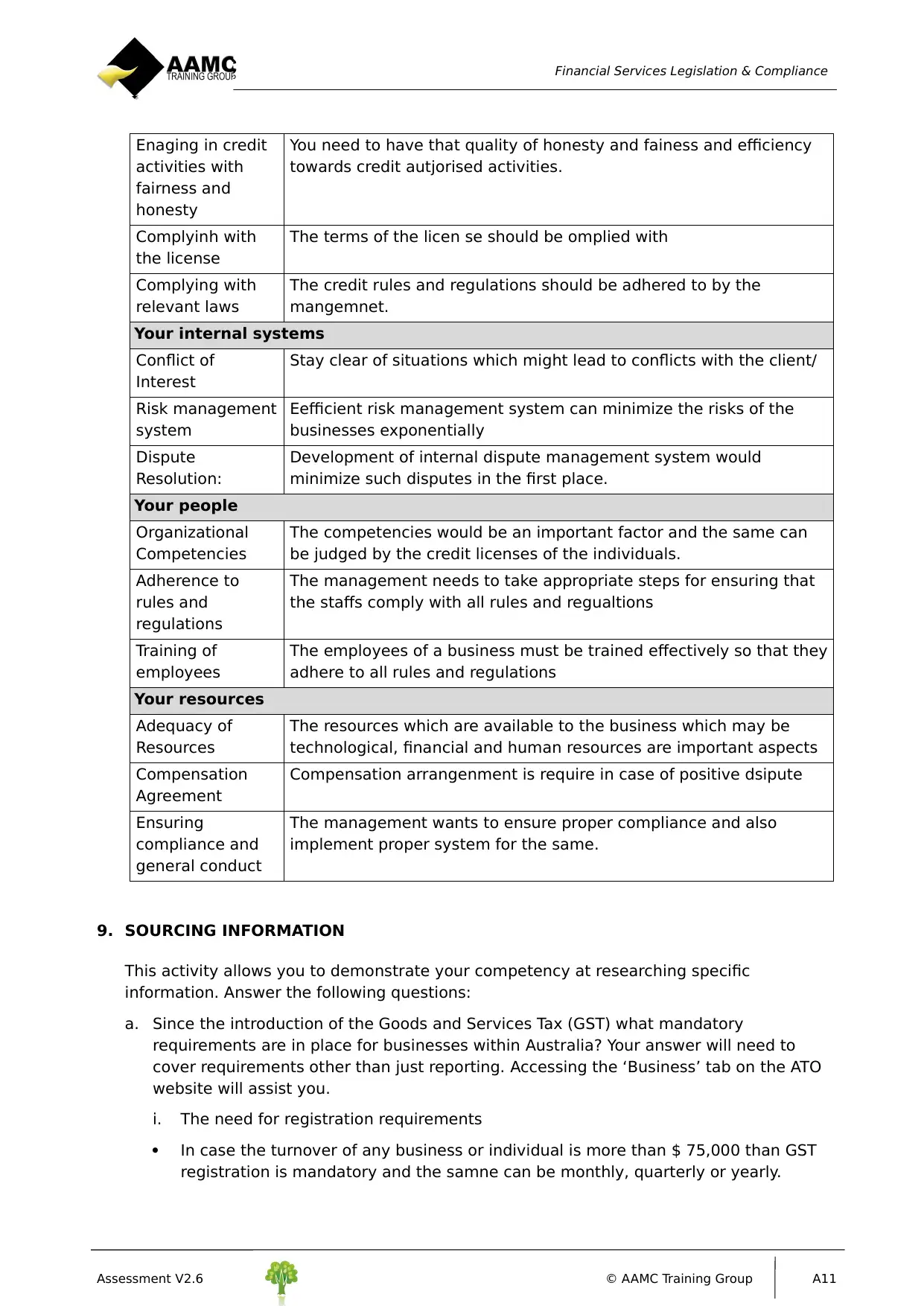
Financial Services Legislation & Compliance
Enaging in credit
activities with
fairness and
honesty
You need to have that quality of honesty and fainess and efficiency
towards credit autjorised activities.
Complyinh with
the license
The terms of the licen se should be omplied with
Complying with
relevant laws
The credit rules and regulations should be adhered to by the
mangemnet.
Your internal systems
Conflict of
Interest
Stay clear of situations which might lead to conflicts with the client/
Risk management
system
Eefficient risk management system can minimize the risks of the
businesses exponentially
Dispute
Resolution:
Development of internal dispute management system would
minimize such disputes in the first place.
Your people
Organizational
Competencies
The competencies would be an important factor and the same can
be judged by the credit licenses of the individuals.
Adherence to
rules and
regulations
The management needs to take appropriate steps for ensuring that
the staffs comply with all rules and regualtions
Training of
employees
The employees of a business must be trained effectively so that they
adhere to all rules and regulations
Your resources
Adequacy of
Resources
The resources which are available to the business which may be
technological, financial and human resources are important aspects
Compensation
Agreement
Compensation arrangenment is require in case of positive dsipute
Ensuring
compliance and
general conduct
The management wants to ensure proper compliance and also
implement proper system for the same.
9. SOURCING INFORMATION
This activity allows you to demonstrate your competency at researching specific
information. Answer the following questions:
a. Since the introduction of the Goods and Services Tax (GST) what mandatory
requirements are in place for businesses within Australia? Your answer will need to
cover requirements other than just reporting. Accessing the ‘Business’ tab on the ATO
website will assist you.
i. The need for registration requirements
In case the turnover of any business or individual is more than $ 75,000 than GST
registration is mandatory and the samne can be monthly, quarterly or yearly.
Assessment V2.6 © AAMC Training Group A11
Enaging in credit
activities with
fairness and
honesty
You need to have that quality of honesty and fainess and efficiency
towards credit autjorised activities.
Complyinh with
the license
The terms of the licen se should be omplied with
Complying with
relevant laws
The credit rules and regulations should be adhered to by the
mangemnet.
Your internal systems
Conflict of
Interest
Stay clear of situations which might lead to conflicts with the client/
Risk management
system
Eefficient risk management system can minimize the risks of the
businesses exponentially
Dispute
Resolution:
Development of internal dispute management system would
minimize such disputes in the first place.
Your people
Organizational
Competencies
The competencies would be an important factor and the same can
be judged by the credit licenses of the individuals.
Adherence to
rules and
regulations
The management needs to take appropriate steps for ensuring that
the staffs comply with all rules and regualtions
Training of
employees
The employees of a business must be trained effectively so that they
adhere to all rules and regulations
Your resources
Adequacy of
Resources
The resources which are available to the business which may be
technological, financial and human resources are important aspects
Compensation
Agreement
Compensation arrangenment is require in case of positive dsipute
Ensuring
compliance and
general conduct
The management wants to ensure proper compliance and also
implement proper system for the same.
9. SOURCING INFORMATION
This activity allows you to demonstrate your competency at researching specific
information. Answer the following questions:
a. Since the introduction of the Goods and Services Tax (GST) what mandatory
requirements are in place for businesses within Australia? Your answer will need to
cover requirements other than just reporting. Accessing the ‘Business’ tab on the ATO
website will assist you.
i. The need for registration requirements
In case the turnover of any business or individual is more than $ 75,000 than GST
registration is mandatory and the samne can be monthly, quarterly or yearly.
Assessment V2.6 © AAMC Training Group A11
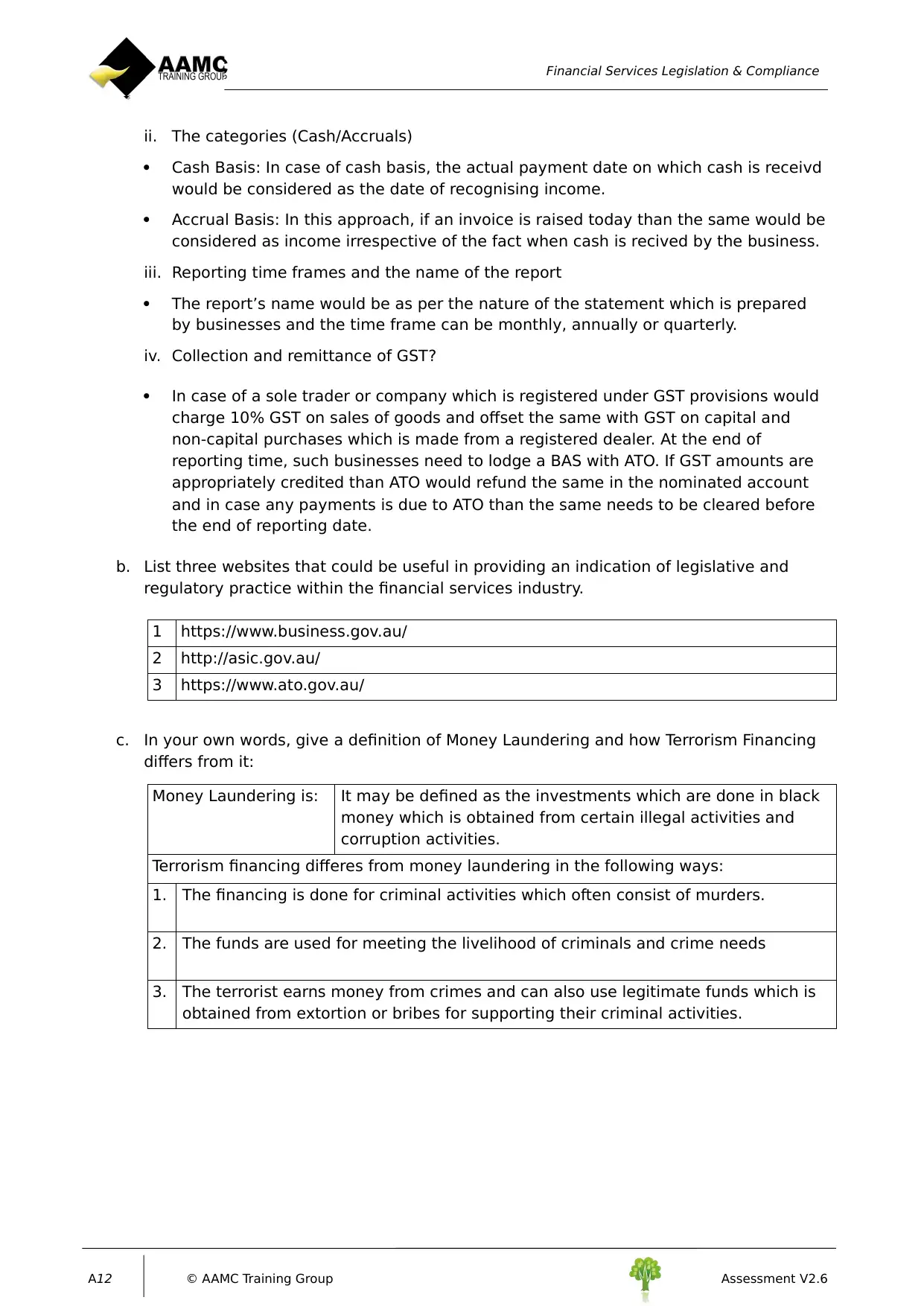
Financial Services Legislation & Compliance
ii. The categories (Cash/Accruals)
Cash Basis: In case of cash basis, the actual payment date on which cash is receivd
would be considered as the date of recognising income.
Accrual Basis: In this approach, if an invoice is raised today than the same would be
considered as income irrespective of the fact when cash is recived by the business.
iii. Reporting time frames and the name of the report
The report’s name would be as per the nature of the statement which is prepared
by businesses and the time frame can be monthly, annually or quarterly.
iv. Collection and remittance of GST?
In case of a sole trader or company which is registered under GST provisions would
charge 10% GST on sales of goods and offset the same with GST on capital and
non-capital purchases which is made from a registered dealer. At the end of
reporting time, such businesses need to lodge a BAS with ATO. If GST amounts are
appropriately credited than ATO would refund the same in the nominated account
and in case any payments is due to ATO than the same needs to be cleared before
the end of reporting date.
b. List three websites that could be useful in providing an indication of legislative and
regulatory practice within the financial services industry.
1 https://www.business.gov.au/
2 http://asic.gov.au/
3 https://www.ato.gov.au/
c. In your own words, give a definition of Money Laundering and how Terrorism Financing
differs from it:
Money Laundering is: It may be defined as the investments which are done in black
money which is obtained from certain illegal activities and
corruption activities.
Terrorism financing differes from money laundering in the following ways:
1. The financing is done for criminal activities which often consist of murders.
2. The funds are used for meeting the livelihood of criminals and crime needs
3. The terrorist earns money from crimes and can also use legitimate funds which is
obtained from extortion or bribes for supporting their criminal activities.
A12 © AAMC Training Group Assessment V2.6
ii. The categories (Cash/Accruals)
Cash Basis: In case of cash basis, the actual payment date on which cash is receivd
would be considered as the date of recognising income.
Accrual Basis: In this approach, if an invoice is raised today than the same would be
considered as income irrespective of the fact when cash is recived by the business.
iii. Reporting time frames and the name of the report
The report’s name would be as per the nature of the statement which is prepared
by businesses and the time frame can be monthly, annually or quarterly.
iv. Collection and remittance of GST?
In case of a sole trader or company which is registered under GST provisions would
charge 10% GST on sales of goods and offset the same with GST on capital and
non-capital purchases which is made from a registered dealer. At the end of
reporting time, such businesses need to lodge a BAS with ATO. If GST amounts are
appropriately credited than ATO would refund the same in the nominated account
and in case any payments is due to ATO than the same needs to be cleared before
the end of reporting date.
b. List three websites that could be useful in providing an indication of legislative and
regulatory practice within the financial services industry.
1 https://www.business.gov.au/
2 http://asic.gov.au/
3 https://www.ato.gov.au/
c. In your own words, give a definition of Money Laundering and how Terrorism Financing
differs from it:
Money Laundering is: It may be defined as the investments which are done in black
money which is obtained from certain illegal activities and
corruption activities.
Terrorism financing differes from money laundering in the following ways:
1. The financing is done for criminal activities which often consist of murders.
2. The funds are used for meeting the livelihood of criminals and crime needs
3. The terrorist earns money from crimes and can also use legitimate funds which is
obtained from extortion or bribes for supporting their criminal activities.
A12 © AAMC Training Group Assessment V2.6
⊘ This is a preview!⊘
Do you want full access?
Subscribe today to unlock all pages.

Trusted by 1+ million students worldwide
1 out of 18
Related Documents
Your All-in-One AI-Powered Toolkit for Academic Success.
+13062052269
info@desklib.com
Available 24*7 on WhatsApp / Email
![[object Object]](/_next/static/media/star-bottom.7253800d.svg)
Unlock your academic potential
Copyright © 2020–2025 A2Z Services. All Rights Reserved. Developed and managed by ZUCOL.





